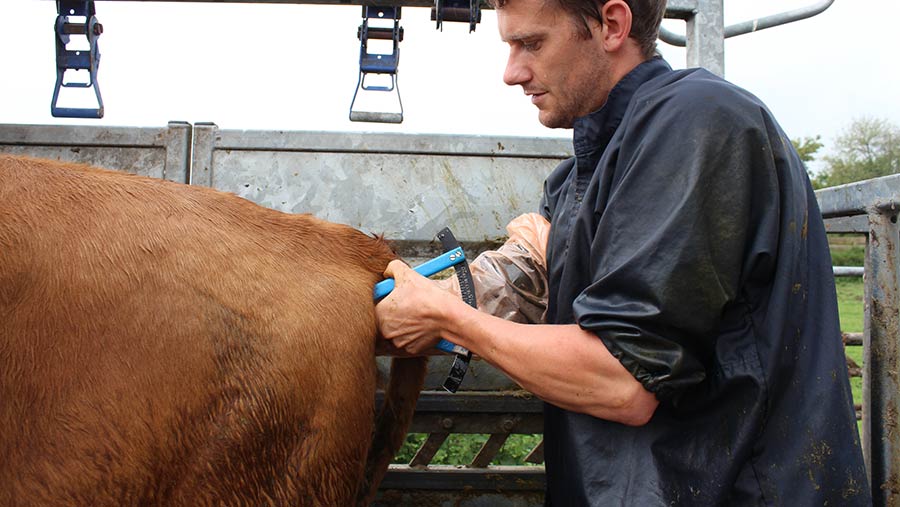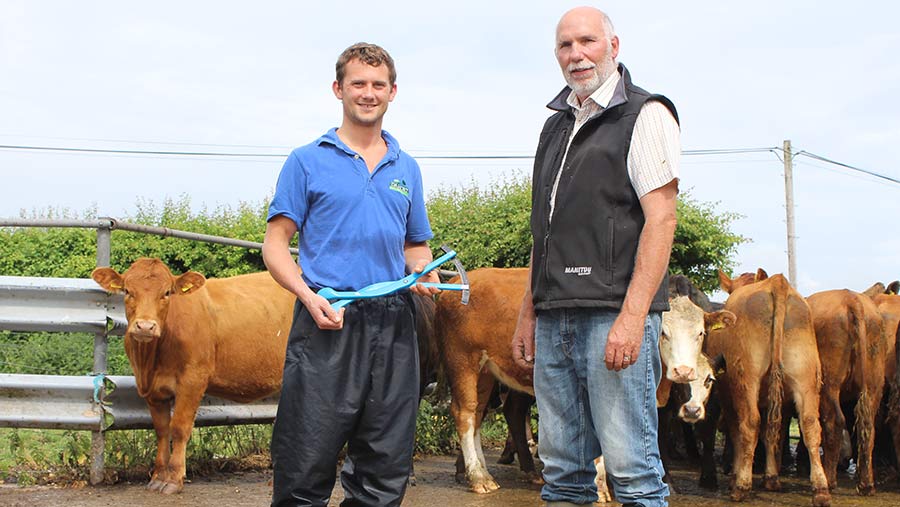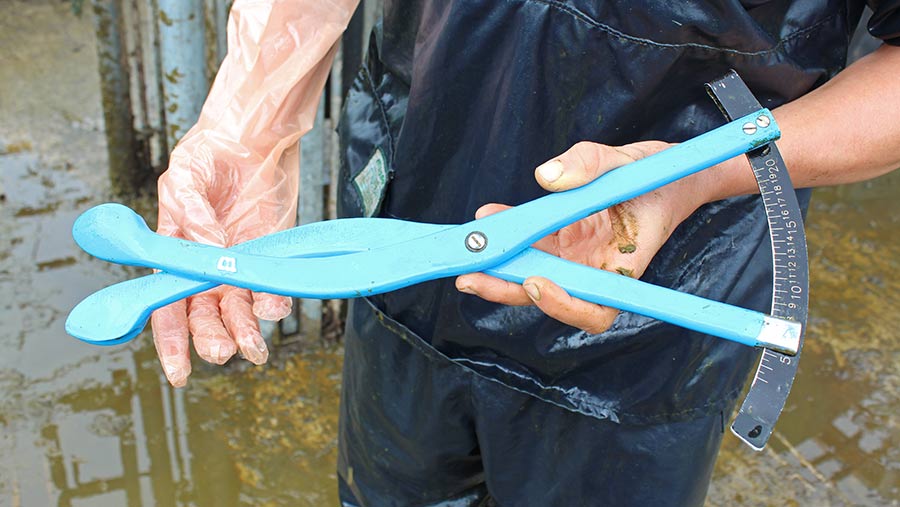Pelvic measuring helps halve assisted calvings and calf losses
 The width and height of the pelvis are measured via the rectum
The width and height of the pelvis are measured via the rectum Dismissing heifers with suboptimal pelvic size before breeding has helped more than halve assisted calvings from 20% of the total to 9% and cut calf losses from 8.6% to 3% at Launceston Farm, Tarrant Launceston.
The farm team’s decision to adopt the practice of assessing heifer pelvic size before service – which is common in the US and New Zealand – was taken in 2016 when calving figures came under the spotlight as part of Damory Vet’s Beef Discussion Group.
Their data showed that most of the calf losses in their 270-cow organic suckler herd occurred in heifers, with many as a result of a protracted or difficult calving.
See also: Pelvic measuring puts spotlight on calving ease EBV
As a result, heifer pelvic measurements and weights are now taken in advance of breeding and used as selection criteria when choosing replacements.
The impact has been marked in this year’s spring calving heifers, with fewer needing assistance or losing calves.
Vet Matthew Burge of Damory Vets believes calf losses as a result of heifers experiencing a difficult or protracted calving are to blame for sub-optimal performance on many beef farms.
This could be one of the reasons that QMS data shows the average farm is achieving about 87% of calves finished per 100 cows and heifers put to the bull, versus a target of 94%.
Mr Burge explains: “When you look at the data from most of our farms, when you add up the number of stillborn calves, calves that die within 24 hours of birth, and the number of animals needing calving assistance or caesarean, the majority of these are heifers.
“And the vast majority of the time, most are from heifers that were underweight at service or with bad pelvises.”

Vet Matthew Burge and herd manager Pete Barrett
As a result, Mr Burge urges farmers to record and identify when calving problems are occurring. If most of the issues are in heifers, actions can then be taken.
Pelvic measurements are a reliable way to identify animals that have small pelvises that could lead to calving difficulties (see panel “Pelvic measurements – how they are carried out”).
Did you know?
One in 20 animals have small pelvises which can cause calving problems
From his experiences of pelvic measuring, Mr Burge says about one in 20 animals can be expected to have small pelvises, which are likely to cause calving problems.
These animals should be culled. Two or three in 20 will have marginal pelvises.
These should ideally not be bred or bred to an easy calving bull.
Weighing also forms a vital component of pre-breeding assessment, because sub-optimal heifer size will negatively affect conception rates.
Breeding at Launceston Farm
At Launceston Farm, farmer Jimi Collis has always weighed heifers as a means of assessing whether animals are ready for service at 15 months to calve at 24 months.
However, due to herd expansion over the past four years, some animals under the optimum 65% of adult weight at service may have been put to the bull.
This was leading to higher barren rates, which were also affected by delayed leptospirosis vaccination in 2016.
Having now reached optimum herd size, Mr Collis and herd manager Pete Barrett are being more selective with the heifers they put to the bull, based on pelvic measurements and weights.
Farm Facts
- 270 suckler cows
- 180 spring block calving, 90 autumn block calving
- Aberdeen Angus base crossed to Limousin and some Simmental. Now introducing Stabiliser genetics to improve maternal traits
- Always select bulls within the top 5% for calving ease
Heifers must now be over 360-380kg at service, depending on breed, and with a good pelvis.
When a group of 33 spring-born heifers were assessed at the end of May, about half were under the optimum service weight, two were freemartins and three were advised to be culled due to marginal pelvises.
A higher number of heifers than needed will always be initially inspected, with the aim of breeding enough to meet a 10% replacement rate.
The high proportion of small heifers this year is a result of a poor out-wintering turnip crop, coupled with the Beast from the East.
The heifers that fell out of spec will now be fattened and sold.
Retaining all heifers for breeding
On farms that need to retain all heifers for breeding, Mr Burge advises planning in advance to ensure animals meet growth targets.
This could include splitting heifers off soon after weaning so they can be preferentially fed to achieve bulling weight.
Overall, Mr Barrett is in favour of being more selective in breeding decisions as he believes it helps labour, welfare and costs.
He adds: “Every farmer needs to be seen to be doing everything properly. It’s another tool to show Joe Public we’re doing everything to the best of our ability.”
Benefits of pelvic scoring and weighing
The benefits are clear to see in the herd’s figures.
Since pelvic scoring and weighing, the number of assisted heifer calvings in the spring block has reduced from 21% in 2017 to 9%.

The sliding caliper device used to measure pelvic area
The remaining 9% were due to factors unrelated to heifer size, such as the calf being breached or twins.
Only serving heifers at the correct weight and adhering to vaccine timings has also led to 9% fewer barren heifers.
Mr Collis adds: “We want to be efficient and if we can do that by measuring things not seen to the naked eye, then all the better. It’s so noticeable how much easier they calved. Not just how they calved, but how quickly they calved.”
Pelvic measurements – how they are carried out
- Pelvic measurements should form part of pre-breeding checks, carried out by a vet ideally a few weeks prior to service.
- Weight and heifer age in months are needed for accurate results
- A sliding caliper device is inserted into the rectum
- The width and height of the pelvis are measured and multiplied together to give the pelvic cross-sectional area
- Pelvic area alone is not enough to determine if calving problems will occur. The measurement is divided by a conversion factor, which is determined by the weight and age of the heifer (See table)
- Heifers must have reached puberty for the reading to be accurate
| Conversion factor for calculating expected calving difficulties | ||||||
| Heifer weight (kg) | Age at measurement (months) | |||||
| 8-9 | 10-11 | 12-13 | 14-15 | 16-17 | 18-19 | |
| 230 | 3.7 | 4.1 | 4.4 | |||
| 270 | 4.0 | 4.3 | 4.6 | 4.9 | ||
| 320 | 4.2 | 4.5 | 4.8 | 5.1 | 5.4 | 5.7 |
| 360 | 4.7 | 5.0 | 5.3 | 5.6 | 5.9 | |
| 410 | 5.3 | 5.6 | 5.9 | 6.2 | ||
| 450 | 5.5 | 5.8 | 6.1 | 6.4 | ||
Developed by Damory Vets, based on work by the University of Nebraska
Example calculations using conversion factors
Ideally heifers should be able to birth a 35kg calf without assistance.
- 10-month-old heifer weighing 320kg
- Pelvic cross-sectional area = 12 x 15cm = 180cm2
- 180/4.5 = can be expected to birth a 40kg calf without difficulties
- 12-month-old heifer weighing 360kg
- Pelvic cross-sectional area = 11 x 13cm = 143cm2
- 143/5.0 = can be expected to birth only a 28.6kg calf without difficulty – consider culling or at least breeding to an easy calving bull.
